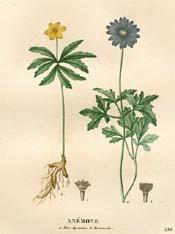
AnemonesFamily: N.O. RanunculaceaeThe Anemones are represented in our native British flora by only two species, the dainty little Wood Anemone (Anemone nemorosa) and the Pasque Flower (A. pulsatilla), both possessing medicinal properties, though the former is little used now. There are, however, about seventy species in the genus Anemone, including the subgenus Hepatica, now also reckoned as Anemones, though formerly ranking as a separate genus, the chief representative of which, A. hepatica, is of some considerable medicinal value. A. pratensis, a continental species, is employed medicinally for the same purposes as A. pulsatilla, and the number of species familiar to us as garden flowers is very great, the most popular among these being, perhaps, the Poppy or Garden Anemone, A. coronavria a native of the Levant and Southern Europe, introduced here in 1596, and the Star Anemone, A. hortensis, a native of Italy, brought to England from Holland about the same time. A. apennina and A. blanda are also particularly charming the latter with large flowers of various shades of blue being the earliest to open. ---Description---The distinguishing characteristics of the genus Anemone are the presence of three entire leaflets arranged in a whorl just under the flowers, forming an involucre, and the fact that the flowers themselves have no real petals, but a calyx of six to eight petal-like sepals. All species share the acrid and bitter nature of almost all plants of the Ranunculus order to which they belong, and the leaves and flowers should not be eaten. The toxic principle has been extracted from three species: the two British species and one foreign one, though no actually fatal results have been recorded. A yellow-flowered foreign species, A. ranunculoides, found in almost all parts of the Continent, has been used for poisoning arrows, and in France, swelling and blistering of the hands has resulted from using the juice as a stimulant to ulceration. ---Cultivation---Anemones flourish best in a rich, sandy loam, but will thrive in any garden soil which is well-drained and tolerably light, it should also be enriched with decayed manure. Sea sand, or a little salt mixed with the soil is a good preventive of mildew. Propagation is by division of the rootstocks and cuttings of the root in autumn and early spring - from October to the end of March - and also from seed, which should be sown within a month of ripening, as it deteriorates with keeping. Sow thinly in lines on the surface and merely rake the seeds in with a very light hand. Germination is slow. Thin the plants to 6 inches apart. Thinnings will bear transplanting if carefully handled and helped with water afterwards. The first flowers are generally produced the first spring after sowing, but soil and situation have always a great effect on them. Some persons take up Anemone tubers as soon as the leaf has died down, and replant in the early part of the year, but this is not necessary: those that have been two or three years in the ground attain a large size - they are solid, flattened masses, not unlike ginger. When planting, cover with soil to the depth of 3 inches. Most garden Anemones can be treated in this way. The best time for transplanting A. pulsatilla is considered to be directly after it has flowered, or at any rate during the summer, while it is in growth; autumn is a bad time and early spring not much better. [Top] © Copyright Protected 1995-2004 botanical.com
|
|
| GuestBook |
STUMBLE-UPON: NATIVE AMERICAN EMBASSY: HOME PAGE:

|
Copyright(s) © 1991-2012: Lenni Lenape Phoenix, Native American Embassy, Mandy & NATIVE ENIT, Native American Holocaust Museum, Inc., Minister Jessie Renee (Von Noaker) ThunderWolfe, Priscylla Belle Venticello, Von Noaker Family Publishing Group International North American Homeless Ombudsman Council
Copying in any form or medium is strictly forbidden without prior written permission: Illegal copying (Taking Possession of) anything within this Web Domain contitutes "Criminal Theft of (Intelectual) Property & will be treated as such! |
|
|
|
VISITOR STATISTICS: TREEPAD
|
|
CONTACT INFORMATION: NATIVE AMERICAN EMBASSY 1413 Union Avenue McKeesport, Pennsylvania 15132 USA PHONE: [VOICEMAIL ONLY HOTLINE (News, Reports, etc.)]: (412) 436-3866 Pennsylvania, Pittsburgh Office: (412) 689-9051 Pennsylvania, Johnstown Office: Private: Auto Transfers To Hawaiian Office HAWAIIAN OFFICE & MAIN NORTH AMERICAN (U.S.) OFFICE: (808) 445-6576 CANADIAN OFFICE (British Columbia): (250) 900-0405 NEW YORK OFFICE: (631) 913-3475 OKLAHOMA OFFICE: (405) 225-6124 |
|

